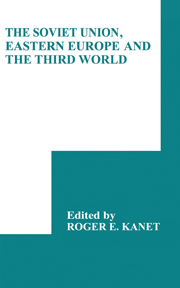Book contents
- Frontmatter
- Contents
- List of figures
- List of tables
- List of contributors
- Foreword by R.C. Elwood
- Preface by Roger E. Kanet
- PART 1 THE THIRD WORLD IN SOVIET FOREIGN POLICY
- PART 2 CMEA ECONOMIC INVOLVEMENT IN THE THIRD WORLD
- 6 Soviet economic policy in the Third World
- 7 Eastern Europe and the Third World: Economic interactions and policies
- 8 The non-European members of the CMEA: a model for developing countries?
- PART 3 THE SOVIET UNION IN THE MIDDLE EAST AND SOUTH ASIA
- Index
- Publications from the Third World Congress for Soviet and East European Studies, Washington, 1985
6 - Soviet economic policy in the Third World
from PART 2 - CMEA ECONOMIC INVOLVEMENT IN THE THIRD WORLD
Published online by Cambridge University Press: 06 July 2010
- Frontmatter
- Contents
- List of figures
- List of tables
- List of contributors
- Foreword by R.C. Elwood
- Preface by Roger E. Kanet
- PART 1 THE THIRD WORLD IN SOVIET FOREIGN POLICY
- PART 2 CMEA ECONOMIC INVOLVEMENT IN THE THIRD WORLD
- 6 Soviet economic policy in the Third World
- 7 Eastern Europe and the Third World: Economic interactions and policies
- 8 The non-European members of the CMEA: a model for developing countries?
- PART 3 THE SOVIET UNION IN THE MIDDLE EAST AND SOUTH ASIA
- Index
- Publications from the Third World Congress for Soviet and East European Studies, Washington, 1985
Summary
Since the mid-1950s the Soviet Union has intensified its efforts to develop ties with the non-communist countries of the Third World and has endeavored to assert its political influence in these parts of the world. Whereas Khrushchev's efforts were classed by the West under the rubric “commitment and adventurism,” Brezhnev's later policy has been praised as “highly rationalistic, realistic, pragmatic, and, until Angola, cautious.” The reference to Soviet–Cuban intervention in Angola (1975–76) is an expression of growing Western fear that the spectacular spread of Soviet power in the Third World could inflict damage on the economic interests of Western industrialized countries. The Soviet invasion of Afghanistan in 1979 not only heightened these fears, it triggered (primarily in the United States) an outright “perception revolution” with regard to the future goals of Soviet policy towards the Third World and the very nature of Soviet foreign policy in general.
Analysis of political and economic relations between the Soviet Union and the developing countries encounters fairly serious difficulties. There is no public Soviet discussion of goals and resource commitment; the same applies to gains and costs incurred by the Soviet Union through its relations with “the South.” Soviet public policy statements and press accounts are laden with ideology and propaganda; often they are hollow slogans that do not lend themselves well to analysis. Moreover, published Soviet economic statistics have only limited information value and are incomplete.
- Type
- Chapter
- Information
- The Soviet Union, Eastern Europe and the Third World , pp. 117 - 140Publisher: Cambridge University PressPrint publication year: 1988

